 On August 25, 2012, the world learned the sad news of the death of Neil Armstrong, the first man to walk on the moon.
On August 25, 2012, the world learned the sad news of the death of Neil Armstrong, the first man to walk on the moon.
In this post, we'll take a closer look at the Apollo 11 mission, and just what it took to get Neil Armstrong and Buzz Aldrin to the moon and back.
James Burke, whom you probably know from his documentary series Connections and The Day The Universe Changed, was the main presenter and science reporter for the BBC back in 1969. His style of reporting really brought the Apollo 11 challenge to life. As seen in the videos in this playlist, he shows the cramped, yet functional, command module, the workings of the spacesuit, the escape plans, what zero gravity testing is like, and more!
As James Burke explains in more detail below, what NASA was really trying to do was launch a 36-story building at the Earth in such a way that it doesn't come back down:
One of the most impressive parts of the Apollo 11 mission was the workings of the computer itself. Compared to today's commercially available computers or mobile devices, the specs were amazing primitive. According to Grant Robertson's article, How powerful was the Apollo 11 computer?, the Apollo 11's computer only had 2K of memory and 32K of read-only storage. Simple, but quite capable of doing everything it needed to get to the moon.
For an even more detailed look at the computing power of Apollo 11, check out the Apollo Guidance Computer episode of “Moon Machines”, available on YouTube (Part 1, Part 2, Part 3). If you enjoy that, check out the rest of the “Moon Machines” documentary series.
Part of the whole triumph of landing men on the moon was the way the world seemed to stop and hold its breath together. The video below shows not only the landing itself, but also the world reaction to the feat at the time:
Sadly, the Apollo 11 mission, and even the subsequent Space Shuttle program, are now history. Yes, at the time it fired the imagination. Returning to James Burke again, he explains how imagination is not only the source of the program, but also its demise:
The fact that Neil Armstrong survived to return to Earth and live another 43 years is impressive itself. When trying something new and untested like sending a manned mission to the moon, you have to accept that there's a strong possibility of failure. It's not pleasant to think about, but the Nixon administration did have a speech prepared, in the event that Neil Armstrong and Buzz Aldrin found themselves trapped on the moon.
Neil Armstrong, you were a hero to the U.S. and the world. We are truly saddened to hear of your passing, and will continue to honor your memory.








 In today's post, I've gathered a few free goodies for you!
In today's post, I've gathered a few free goodies for you! (NOTE:
(NOTE: 


